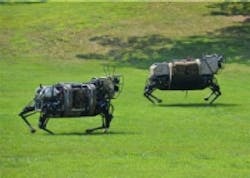Global spending on robotics is expected to more than quadruple from just over $15 billion in 2010 to approximately $67 billion by 2015 at a 10.4% compound annual growth rate (CAGR), according to a report released by The Boston Consulting Group (BCG).
The report cites a number of reasons for this significant growth, beginning with advancing technologies. Today’s robots are becomingly increasingly more responsive and flexible, while prices are coming down, leading to robots penetrating new markets. These include, but are not limited to, commercial applications and the personal service realm, according to BCG. The use of robots such as these, along those already sold in industrial and military uses, will begin to proliferate.
One particular type of robot that has been an oft-discussed topic and bears mentioning here is the collaborative robot. Instead of replacing jobs, these robots are designed to work alongside people. The Robotics Industries Association recently held its first Collaborative Robots Workshop at the AIA Vision Show. As a result of its success, the association announced a stand-alone workshop to be held in Silicon Valley.
"Collaborative robots are one of the hottest topics in robotics right now," said Jeff Burnstein, President of the Association for Advancing Automation. "We held a sold-out event on this topic in Boston during The Vision Show last April, but felt there was far more to cover in order to better communicate what’s happening globally in collaborative robots”
Big three management consulting firm Boston Consulting Group studied the full spectrum of the global robotics market, which it broke down by sectors:
- Personal robots. These are robots that are used for entertainment, cleaning, education, security, and household duties. This segment is expected to grow the fastest, at a CAGR of 15.8% from $1 billion in 2010 to $9 billion in 2025.
- Commercial robots. These are robots used for medical and surgical purposes, agriculture, and construction. This segment is expected to grow at a CAGR of 11.8% from $3.2 billion to $17 billion.
- Industrial robots. These are robots used in factory automation, welding, painting, assembly, and materials handling. This segment is expected to remain the largest, growing at a CAGR of 10.1% from $5.8 billion to $24.4 billion, perhaps aided by the rise of collaborative robots.
- Military robots. These are robots used in UAV, ground, or underwater vehicles in military applications. This segment is expected to grow at a CAGR of 8.1% to $16.5 billion.
Page 1 | Page 2
About the Author

James Carroll
Former VSD Editor James Carroll joined the team 2013. Carroll covered machine vision and imaging from numerous angles, including application stories, industry news, market updates, and new products. In addition to writing and editing articles, Carroll managed the Innovators Awards program and webcasts.

